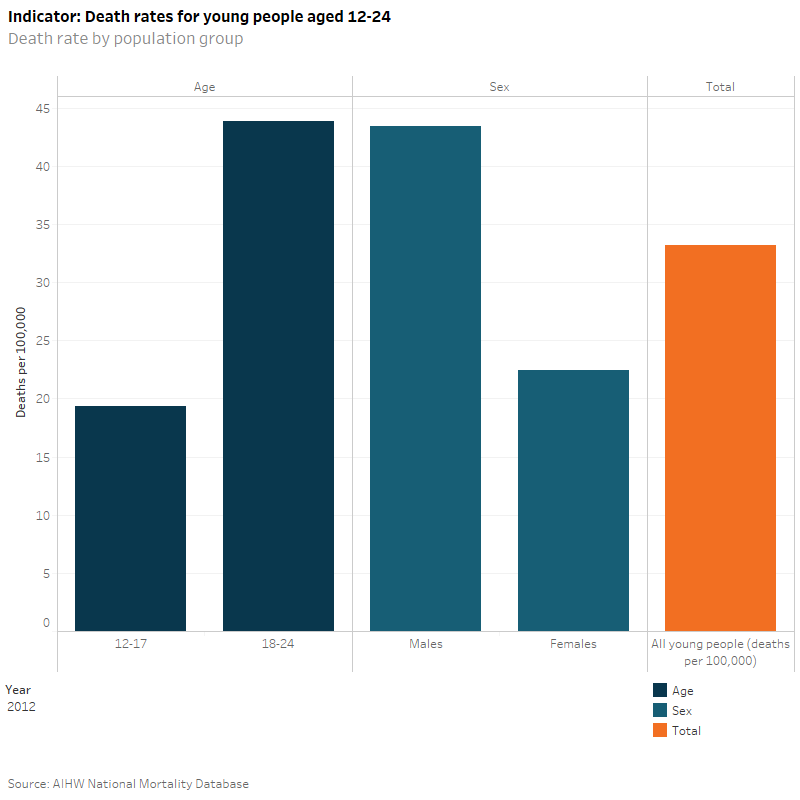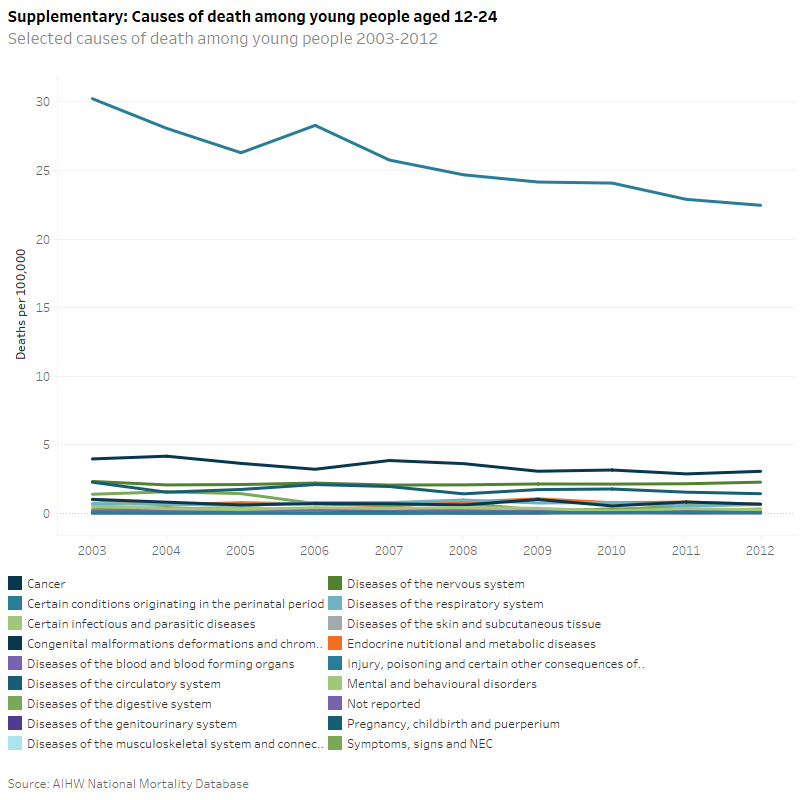Deaths
Why are death rates important?
Mortality rates and the causes of mortality are important indicators of the health of Australia’s young people. They provide insight into the circumstances around the time of death as well as insight into changes in social, environmental conditions, medical interventions, behaviours and trends in underlying risk factors during adolescence and into young adulthood.
High mortality rates among young people, as for the general population, are strongly associated with social and economic disadvantage. For all age groups, and for both males and females, the levels of mortality are higher, and life expectancy is lower among the most socioeconomically disadvantaged populations (Draper et al. 2004).
Young adults and adolescents tend to engage in more risky behaviours which can result in injury and death. These behaviours include risky driving and intentional injuries such as self-harm, suicide and assault (AIHW 2014).
This indicator reports on deaths from all causes. For information on deaths from some selected causes, see Injury deaths, Road fatalities and Suicide.
Do rates vary across population groups?
According to the AIHW National Mortality Database, the death rate among all young people in 2012 was 33 deaths per 100,000. Young people aged 18–24 had a death rate more than twice as high as that for 12–17 year olds (44 per 100,000 compared to 19 per 100,000). Similarly, young males were almost twice as likely to die as young females, with rates of 43 and 22 per 100,000 respectively. The greatest disparity in death rates was for Indigenous young people, who had a death rate almost 2.5 times as high as the death rate for Other Australian young people (80 per 100,000 compared to 32 per 100,000).
The most commonly reported cause of death among young people in 2012 was the category injury, poisoning and certain other causes (22 per 100,000). This rate was considerably higher than any of the other reported causes of death, with cancer and diseases of the nervous system the second and third most commonly reported deaths (3.1 and 2.3 per 100,000 respectively).
Has there been a change over time?
Between 2003 and 2012, there has been a steady decline in the death rate of all young people, from 44 per 100,000 to 33 per 100,000. This appears to be largely driven by a reduction in the death rate of 18–24 year olds (61 per 100,000 to 44 per 100,000). The decline in the death rate of 12–17 year olds has been less pronounced over this period (26 per 100,000 to 19 per 100,000). Similarly, there has been a large reduction in the death rate of young males over this period (62 per 100,000 to 43 per 100,000), with only slight reductions in the death rate of young females (26 per 100,000 to 22 per 100,000). There is no clear trend in the death rate of Indigenous young people with values fluctuating between 77 and 84 deaths per 100,000 from 2003–07 to 2008–12. Conversely, the death rate of Other Australian young people has steadily declined over this period from 38 per 100,000 to 32 per 100,000.
Between 2003 and 2012, there has been an overall decline in the death rate from all causes (44 per 100,000 to 33 per 100,000), largely driven by the reduction in deaths caused by injury, poisoning and other external causes (30 per 100,000 to 22 per 100,000). There also appears to be a reduction in the deaths caused by cancer over this period (4.0 per 100,000 to 3.1 per 100,000), although these trends are more variable. Deaths caused by nervous system diseases remained steady between 2003 and 2012, with the rate decreasing slightly from 2.3 per 100,000 to 2.1 per 100,000 between 2003 and 2004 before gradually returning to 2.3 per 100,000 in 2012.


Other Australians include those who identify as non-Indigenous and those for whom Indigenous status was not stated.
Due to small numbers, Indigenous status data are reported for 5 year periods.
AIHW National Mortality Database
Data quality statement: ABS, Deaths, Australia
AIHW (Australian Institute of Health and Welfare) 2014. Australia’s health 2014. Australia’s health series no. 14. Cat. no. AUS 178. Canberra: AIHW.
Draper G, Turrell G & Oldenburg B 2004. Health Inequalities in Australia: Mortality. Health Inequalities Monitoring Series No. 1. AIHW Cat. No. PHE 55. Canberra: Queensland University of Technology and the Australian Institute of Health and Welfare.


